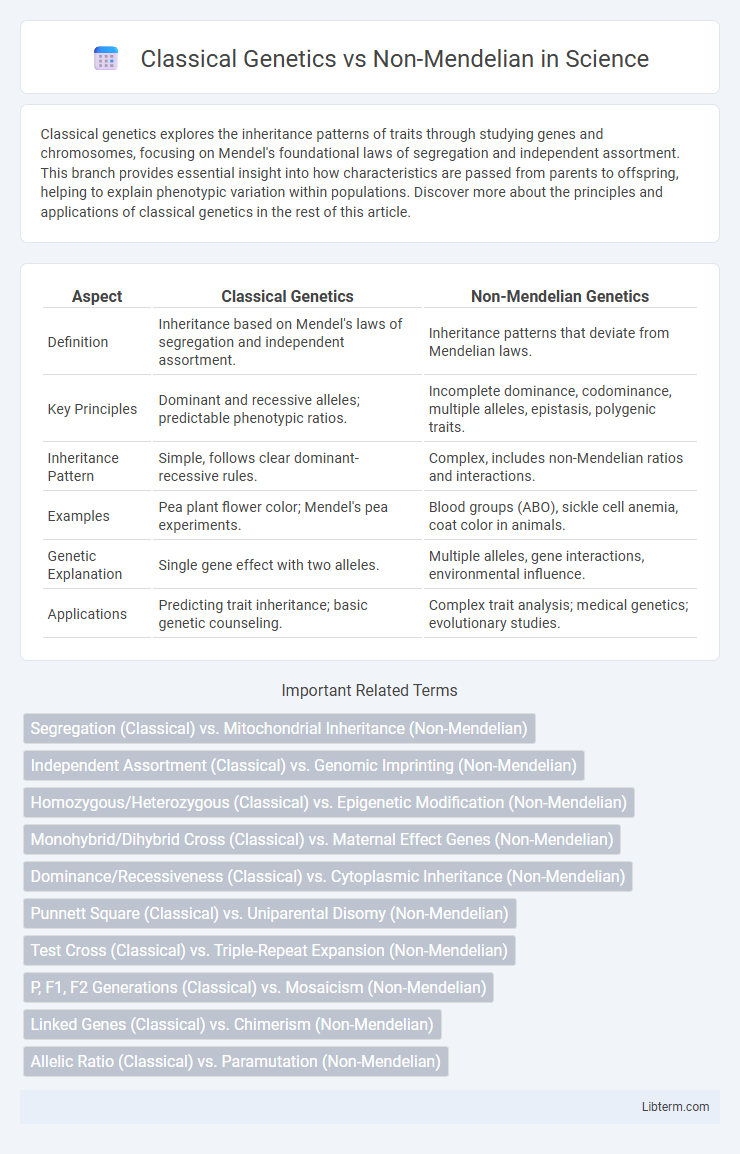Classical genetics explores the inheritance patterns of traits through studying genes and chromosomes, focusing on Mendel's foundational laws of segregation and independent assortment. This branch provides essential insight into how characteristics are passed from parents to offspring, helping to explain phenotypic variation within populations. Discover more about the principles and applications of classical genetics in the rest of this article.
Table of Comparison
| Aspect | Classical Genetics | Non-Mendelian Genetics |
|---|---|---|
| Definition | Inheritance based on Mendel's laws of segregation and independent assortment. | Inheritance patterns that deviate from Mendelian laws. |
| Key Principles | Dominant and recessive alleles; predictable phenotypic ratios. | Incomplete dominance, codominance, multiple alleles, epistasis, polygenic traits. |
| Inheritance Pattern | Simple, follows clear dominant-recessive rules. | Complex, includes non-Mendelian ratios and interactions. |
| Examples | Pea plant flower color; Mendel's pea experiments. | Blood groups (ABO), sickle cell anemia, coat color in animals. |
| Genetic Explanation | Single gene effect with two alleles. | Multiple alleles, gene interactions, environmental influence. |
| Applications | Predicting trait inheritance; basic genetic counseling. | Complex trait analysis; medical genetics; evolutionary studies. |
Introduction to Classical Genetics and Non-Mendelian Inheritance
Classical genetics, founded on Gregor Mendel's principles of inheritance, primarily explores how traits are passed from parents to offspring through dominant and recessive alleles within predictable patterns. Non-Mendelian inheritance encompasses genetic phenomena that deviate from these traditional rules, including incomplete dominance, codominance, mitochondrial inheritance, and epigenetic modifications. Understanding both classical genetics and non-Mendelian inheritance is essential for comprehending the complexity of gene expression and heredity beyond Mendel's original laws.
Historical Overview of Genetic Theories
Classical genetics, established by Gregor Mendel in the mid-19th century, laid the foundation for inheritance principles through experiments with pea plants, introducing dominant and recessive traits. Non-Mendelian genetics emerged in the early 20th century, expanding genetic understanding with discoveries of incomplete dominance, codominance, polygenic inheritance, and epigenetic factors. Key figures such as Thomas Hunt Morgan contributed to linking genes to chromosomes, while later research by Barbara McClintock revealed transposable elements, revolutionizing genetic theory beyond Mendel's laws.
Key Principles of Mendelian (Classical) Genetics
Classical genetics, based on Mendel's key principles, includes the law of segregation, which states that alleles separate during gamete formation, and the law of independent assortment, indicating that genes on different chromosomes assort independently. Mendelian inheritance emphasizes discrete traits determined by dominant and recessive alleles passed from parents to offspring. In contrast, Non-Mendelian genetics explores phenomena like incomplete dominance, codominance, and gene interactions that deviate from these strict classical patterns.
Core Concepts in Non-Mendelian Genetics
Non-Mendelian genetics explores inheritance patterns that deviate from Gregor Mendel's principles, including incomplete dominance, codominance, multiple alleles, and polygenic traits. These core concepts reveal the complexity of gene expression where heterozygous phenotypes blend or multiple alleles influence a single trait, challenging the simple dominant-recessive model. The study of epigenetics and gene linkage further expands understanding of how environmental factors and gene interactions affect heredity beyond Mendelian laws.
Major Differences Between Mendelian and Non-Mendelian Inheritance
Mendelian inheritance follows predictable patterns based on dominant and recessive alleles, exemplified by Gregor Mendel's pea plant experiments, where traits segregate and assort independently. Non-Mendelian inheritance includes phenomena such as incomplete dominance, codominance, multiple alleles, mitochondrial inheritance, and epigenetic modifications, which do not conform to simple Mendelian ratios. Major differences involve the inheritance patterns, gene interactions, and exceptions to Mendel's laws observed in non-Mendelian genetics.
Examples of Mendelian Inheritance Patterns
Mendelian inheritance patterns include autosomal dominant traits like Huntington's disease, autosomal recessive traits such as cystic fibrosis, and sex-linked traits exemplified by hemophilia. These patterns follow predictable ratios based on Mendel's laws of segregation and independent assortment. In contrast, Non-Mendelian inheritance involves complex mechanisms like incomplete dominance, codominance, mitochondrial inheritance, and polygenic traits that do not adhere to simple dominant-recessive relationships.
Types of Non-Mendelian Inheritance Mechanisms
Classical genetics primarily follows Mendelian inheritance patterns involving dominant and recessive alleles, while Non-Mendelian inheritance includes mechanisms such as incomplete dominance, codominance, multiple alleles, polygenic inheritance, and epigenetic modifications. Types of Non-Mendelian inheritance also encompass mitochondrial inheritance, genomic imprinting, and gene linkage, which deviate from traditional Mendelian ratios. Understanding these complex mechanisms is critical for genetic studies, evolutionary biology, and medical genetics.
Genetic Disorders: Mendelian vs Non-Mendelian Perspectives
Mendelian genetics explains many genetic disorders through simple dominant or recessive inheritance patterns, such as cystic fibrosis and sickle cell anemia, which follow clear Mendelian rules. Non-Mendelian genetics encompasses complex inheritance patterns including mitochondrial inheritance, incomplete dominance, codominance, and polygenic traits, contributing to disorders like mitochondrial diseases and multifactorial conditions such as diabetes. Understanding the distinction between Mendelian and Non-Mendelian inheritance is crucial for accurate diagnosis and personalized treatment strategies in genetic disorders.
Impact of Epigenetics in Non-Mendelian Patterns
Epigenetics significantly influences non-Mendelian inheritance patterns by modifying gene expression without altering DNA sequences, leading to phenomena such as genomic imprinting, X-chromosome inactivation, and transgenerational epigenetic inheritance. These epigenetic mechanisms explain variations in phenotype that classical Mendelian genetics cannot account for, underscoring the complexity of hereditary traits beyond dominant and recessive alleles. Understanding epigenetic modifications is crucial for advancing personalized medicine and elucidating multifactorial diseases influenced by both genetic and environmental factors.
Future Directions in Genetic Research and Applications
Future directions in genetic research emphasize the integration of classical genetics principles with non-Mendelian inheritance patterns such as epigenetics, mitochondrial DNA, and gene-environment interactions. Advances in CRISPR gene editing and genomic sequencing enable precise manipulation and understanding of complex traits beyond simple Mendelian inheritance. Expanding applications include personalized medicine, genetic therapies, and agricultural biotechnology tailored to multi-factorial genetic mechanisms.
Classical Genetics Infographic

 libterm.com
libterm.com